The Onager-class Star Destroyer, nicknamed the Imperial Siege Breaker by members of the Rebel Alliance, was a type of rare capital ship and superweapon deployed by the Galactic Empire that was shrouded in secrecy. Initially developed to swiftly eradicate Separatist holdouts that remained after the Clone Wars and to bring Core Worlds under the control of the Empire, the Onager-class saw service throughout the Imperial Era. Following the deployment of the Death Star, the Onager was considered to be a possibly greater threat than the battle station.
After the decisive Battle of Endor in 4 ABY saw the supposed death of Galactic Emperor Palpatine and the defeat of the Empire, the Onager was seen by the remains of the Empire as a vital instrument to regain power in the Galactic Civil War. There were several examples of the class, including the Cataclysm, the Rakehell, the Sunder, and the Onager-class Testbed. A notable characteristic of the Onager was its alleged kyber-crystal–powered superweapons, which could either be Superheavy Composite Beam Turbolasers or Orbital Bombardment Particle Cannons. These weapons were powerful enough to engage capital ships from extremely long range, as well as conduct cataclysmic assaults on planets.
The Onager was utilized as an orbital bombardment platform that was usually deployed at long range and designed to fatally end the deadlock of strong planetary shields. When conducting these strikes, it targeted the shields' deflector shield generator and other surface defenses. The Star Destroyer was also deployed in anti-fleet actions and specific operations, while being defended by escort vessels and its starfighter complement. In the aftermath of the Galactic Civil War and the rise of the Empire's successor government, the First Order, it was believed by members of the Resistance, a private military force with roots to the Rebel Alliance and New Republic, that the First Order may have used technology or inspiration from the Onager.
The Onager-class Star Destroyer, also referred to as the Imperial Siege Breaker by the Rebel Alliance, was a type of 1,288 meter-long Star Destroyer of the cruiser class and superweapon that was manufactured by Rothana Heavy Engineering under contract by Kuat Drive Yards and cost 376,500,000 credits. Members of the Rebel Alliance believed that the Galactic Empire could build thousands of Onager-class Star Destroyers for the price of a single "planet-killer."
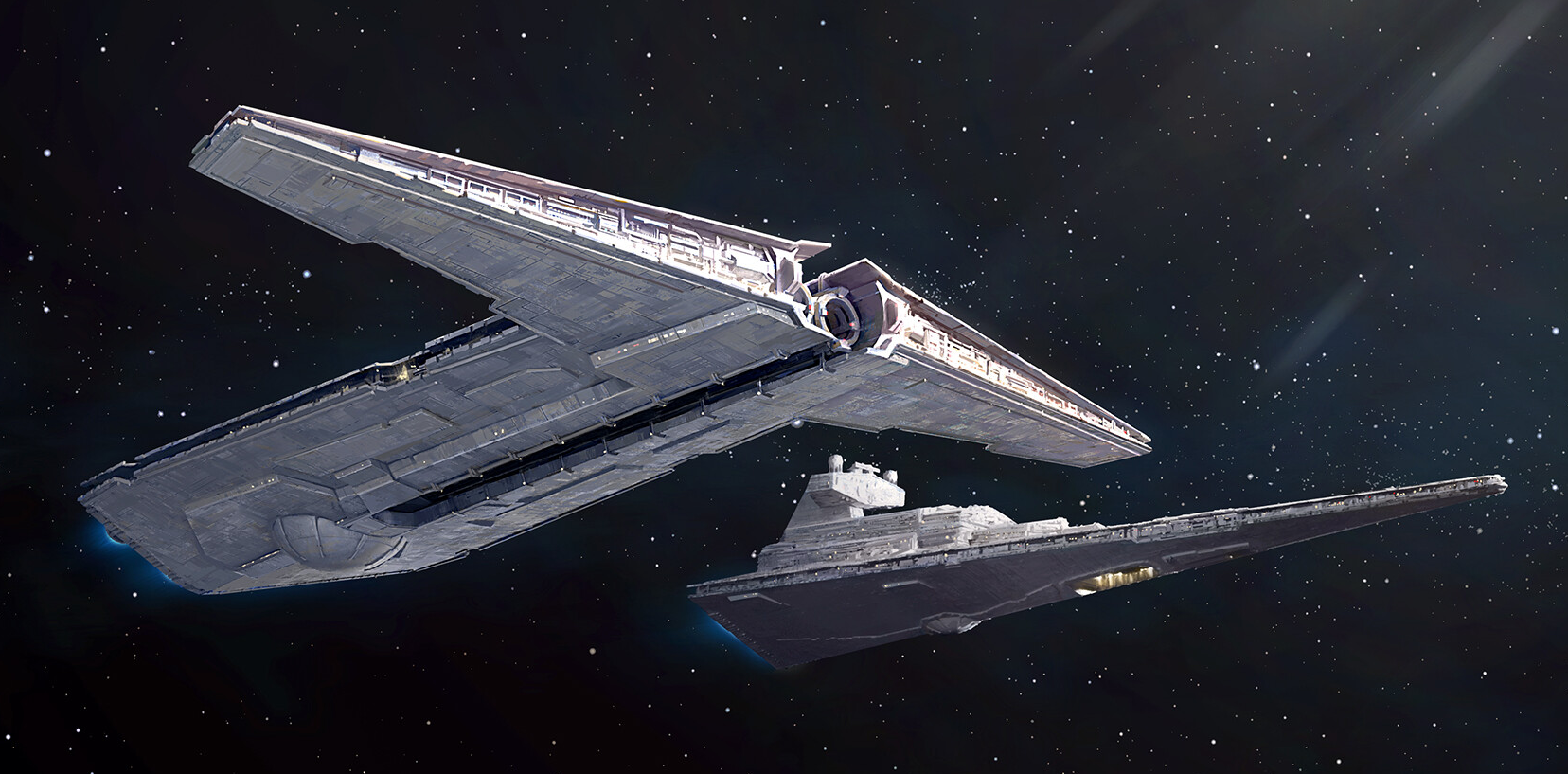
An Onager-class Star Destroyer escorted by an Imperial-class Star Destroyer
The Onager-class was propelled by five sublight engines at the stern of the starship, three of which were larger than the remaining two set between them. The engines were located in the most resistant part of the ship. A solar ionization reactor was located in the ventral hull, characterized by its dome shape. The bridge was placed on a near-trapezoidal structure that was situated on an elevated command tower at the center of the ship toward the rear. The Onager-class Star Destroyer was equipped with advanced targeting and extreme-ranged sensor arrays, as well as a navigation computer. It featured a primary class 1.75 hyperdrive and a class 6 backup.
The front of the ship was distinguished by two prongs that defined the bow as a hammerhead-like T-shaped structure with a long indentation in the center that cut through to almost midship where the primary armament was located. Beyond the end of the indentation but before the command tower structure were two deflector shield generator domes similar to those found in Imperial-class Star Destroyers, as well as several other deflector shield generators. That section of the vessel accommodated the various generators, which concentrated their energy and amplified the ship's offensive potential. The deflector shields, however, were concentrated in the front of the vessel due to the ship's forward firepower being its unique characteristic. More than half of deflector shields were concentrated toward the front of the vessel, and as such, the aft and sides of the Onager-class were more exposed, leaving the engines and flanks vulnerable. The trade-off was considered to be acceptable by the vessel's designers.
In the same fashion as Imperial-class Star Destroyers, the Onager-class had a ridge that traversed the port and starboard sides of the vessel. The Onager-class had two hangar bays, one located on the rear of each of the two prongs that formed the T-shape of the bow. Its complement consisted of six Lambda-class T-4a shuttles and thirty-six TIE fighter series starfighters. The Onager-class was operated by 25,200 personnel that consisted of officers, pilots, and enlisted crew and was capable of holding 240 troops. The vessel maintained consumables for one year.
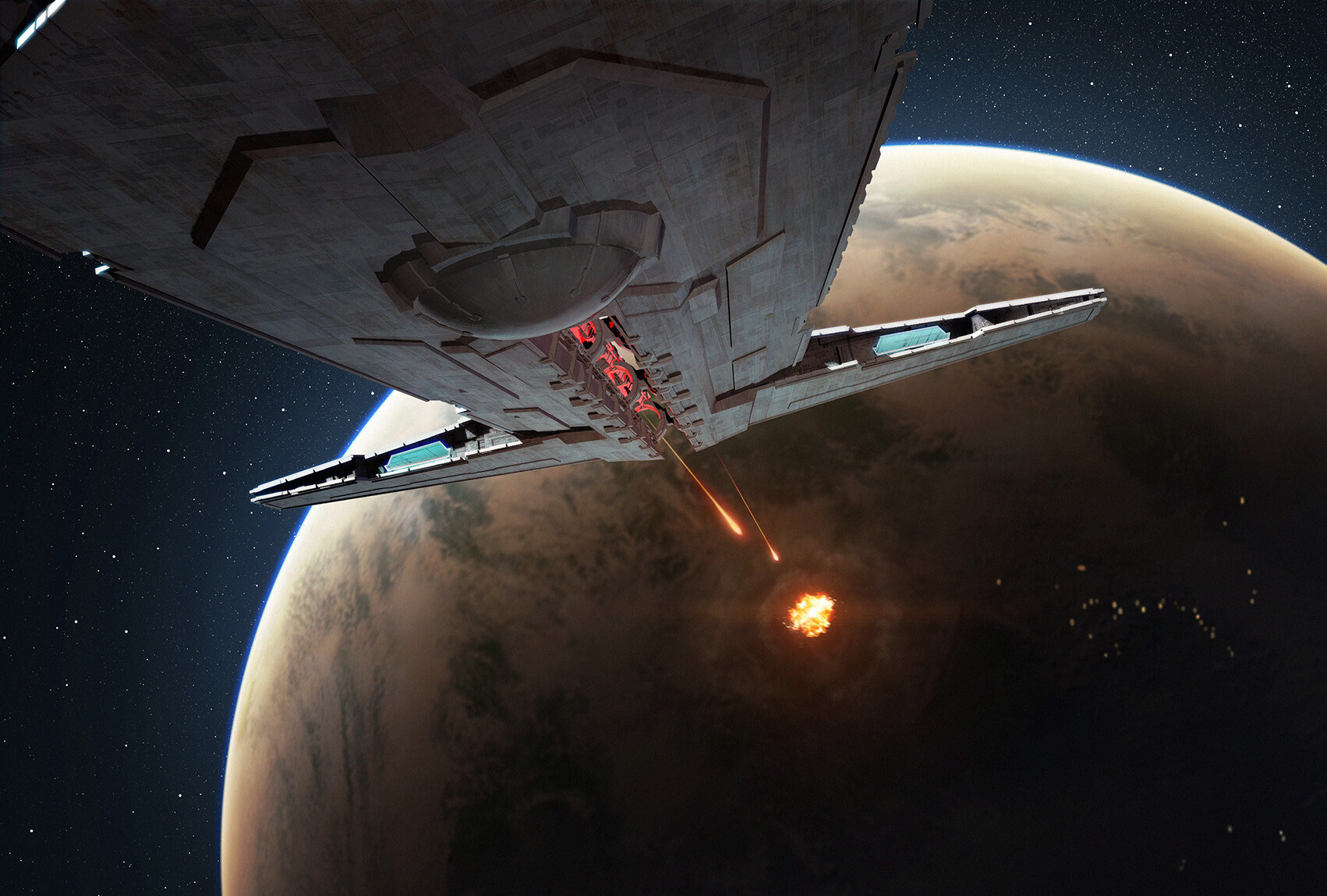
At one point, the Onager-class Testbed fired its Orbital Bombardment Particle Cannons on a terrestrial body.
Located in the indentation was the primary armament of the Onager-class, which was either two shorter-ranged Superheavy Composite Beam Turbolasers that were considered to operate as special battery armaments, or two Orbital Bombardment Particle Cannons that were classified as mass-driver cannons. These weapons were speculated by members of the Rebel Alliance to be powered by kyber crystals. The Alliance believed the crystals were powerful enough to shatter mountains and anything but the strongest energy shield, and so considered the ship to be a superweapon.
These weapons in the indentation of the vessel were longer than half of the ship, with their base located at the start of the chasm near the bridge. Each weapon had at least three rings that were separated along the length of the indentation, through which the weapons' payload passed. When these armaments fired, the indentation and rings glowed red or blue, depending on whether the Orbital Bombardment Particle Cannons or Superheavy Composite Beam Turbolasers were used, respectively.
The particle cannons could fire almost simultaneously one after the other, while the beam turbolasers could be fired at the same time. These two Superheavy Composite Beam Turbolasers and Orbital Bombardment Particle Cannons were considered some of the Galactic Empire's most devastating weaponry and could be used to perform ignition attacks from beyond long range, allowing it to keep the crew of the vessel safe.
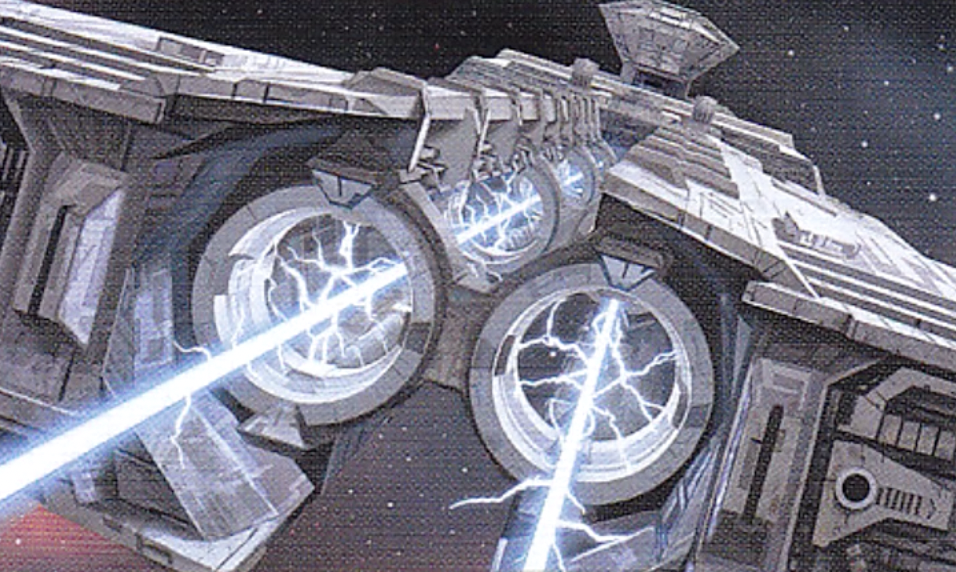
An Onager fires its Superheavy Composite Beam Turbolasers.
Against fleets, the Superheavy Composite Beam Turbolasers focused on using auto-fire to burn through a lone target or sweep several targets as a cutting beam. If it used the Orbital Bombardment Particle Cannons, the Onager attempted to shatter the most dangerous enemy vessel immediately. The primary armaments required an enormous amount of power, and the power conduits were susceptible to attack. The destruction of the main weaponry by a focused strike could cause a catastrophic failure to the ship's systems, leaving it critically damaged or destroyed entirely.
The Onager-class was also equipped with a number of ship-based weaponry throughout its hull ridges on its starboard and port sides, as well as near the hangars in the pronged sections of the ship. These additional armaments were six twin heavy turbolaser batteries evenly divided to the port and starboard, twenty-four heavy turbolaser batteries equally placed on the port and starboard, and twenty point-defense laser cannons evenly distributed to the forward, port, starboard, and aft of the vessel.

At one point during the Imperial Era, the Onager-class Star Destroyer Rakehell was accompanied by two Victory-class Star Destroyers.
The Onager-class Star Destroyer was shrouded in secrecy and was used by the Galactic Empire as a specialized orbital bombardment platform deployed at long range. It was originally conceived to ruthlessly end the deadlock of powerful planetary shields deployed by Separatist holdouts, revolutionary Core Worlds, and other dissident planets. When conducting orbital strikes, it targeted the shield generator and other ground-based defenses. As an uncommon ship, it was used for specific operations. It was also deployed against anti-fleet actions, and in that regard, targeted the largest enemy vessels. It was usually accompanied by escort vessels to protect its flanks, and deployed its starfighters to defend its bow from critical strikes from attacking fighters.
The Rebel Alliance believed that the Siege Breaker, if their intelligence was correct, acted in the capacity of a portable cannon. The deployment of Onager-class Star Destroyers in more sensitive Imperial operations had the characteristic of not being able to be confirmed or denied, and was unlike the common Victory-class and Imperial-class Star Destroyers. Since the Siege Breaker could destroy a base from orbit or punch through a cruiser, it was considered to be a valuable addition to fleets. Although the Death Star was one of the most visible symbols of the Empire's power, it was not their only superweapon, since the Onager-class was hidden in secrecy and may have been considered an even greater threat.
Following the Clone Wars, the Galactic Empire desired a warship that could efficiently and effectively shorten costly prolonged planetary sieges. As such, the Empire promptly developed the Onager-class Star Destroyer to ruthlessly engage planetary shields that were deployed by Separatist holdouts, rebellious Core Worlds, and other dissident planets that did not align with the Empire.
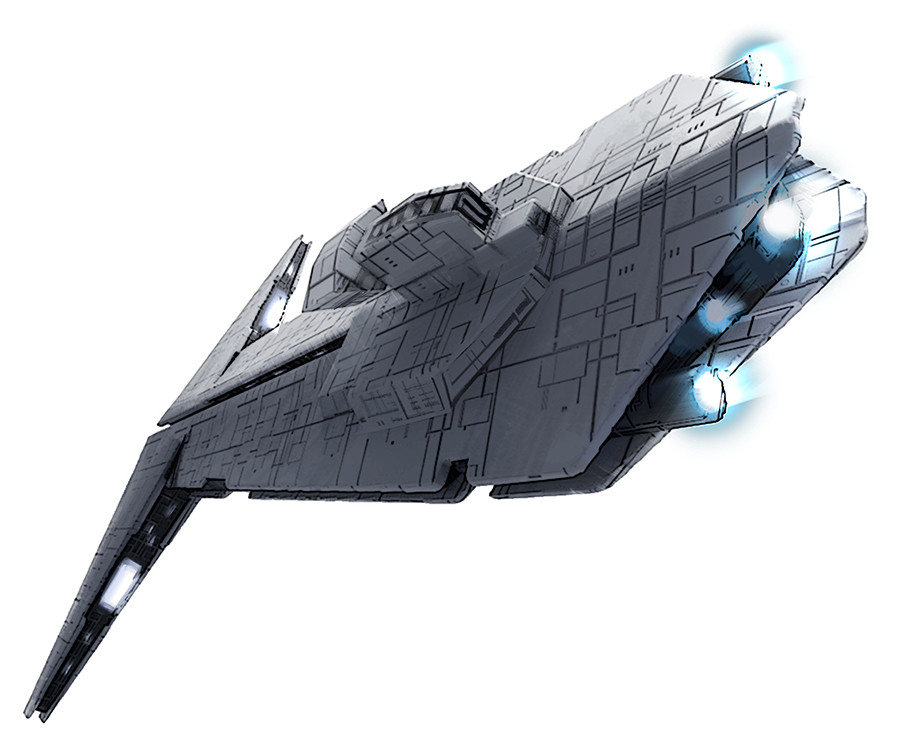
The Rebel Files included an illustration of what the Onager-class Star Destroyer may have looked like.
In 0 BBY, during the Imperial Era, the Rebel Alliance had begun detecting hints of a kyber-crystal–powered superweapon. In reaction to this, Rebel Chief of Intelligence General Airen Cracken allowed Rebel Alliance Intelligence Service Major Capin Harinar and Colonel Haxen Delto to operate independently and theorize based on leads the most likely configuration such a superweapon could take, and both arrived at different conclusions.
Major Harinar gave a report to General Cracken on an Imperial project named Operation: Cinder. Colonel Delto, however, reported to Cracken on what was known as a Siege Breaker. His analysis led him to believe that the Empire could build thousands of relatively smaller cannons, which the Rebel Alliance dubbed Siege Breakers, for the cost of a single "planet-killer." The document also included possible speculation on the characteristics and armament of the Siege Breaker and an illustration of the vessel.
Delto used the document to pursue the principle that the Siege Breaker was more likely than a large "planet-killing" battle station. After receiving both reports by Harinar and Delto, Cracken included them in his own report to Alliance Chancellor and Commander-in-Chief Mon Mothma. It was eventually discovered that the "planet-killer" was the Death Star, a battle station that had the ability to destroy entire worlds. At one point during the Imperial Era, an Imperial moff ordered an Onager-class Star Destroyer to destroy a city from orbit. In another instance, an Alliance installation was destroyed, although it was undetermined if the Empire had equipped a miniaturized Death Star superlaser on an Onager-class or if it was a different circumstance.
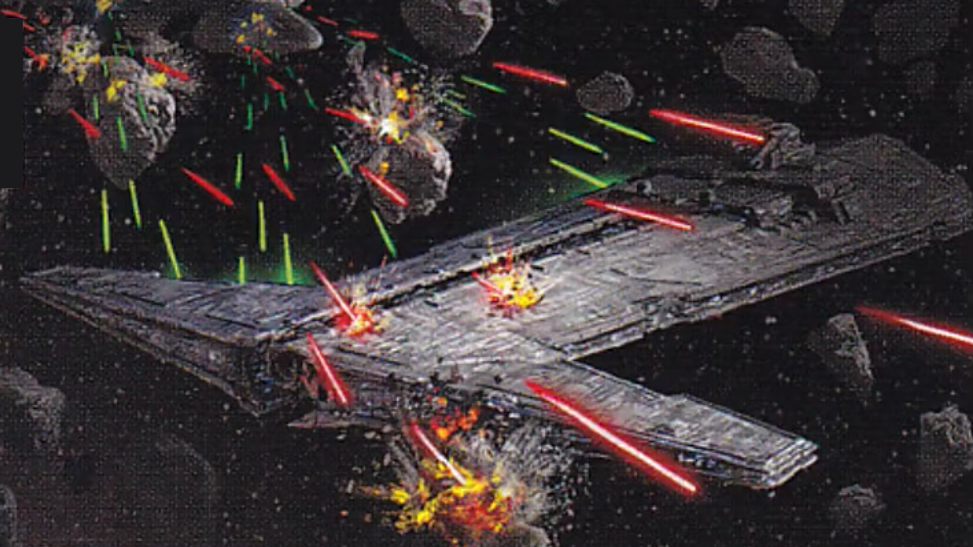
The Sunder fell under attack by a Mon Calamari Star Cruiser.
Eventually, it was discovered that the information gathered by Alliance Intelligence on Operation: Cinder and the Siege Breaker was correct, including the illustration of the Siege Breaker. Although a relative rarity, there were several examples of the Onager, with four being the Rakehell, the Cataclysm, the Sunder, and the Onager-class Testbed. Even during the Galactic Civil War that took place by 4 BBY and lasted to 5 ABY, the Onager-class Star Destroyer was continually refined, and the Testbed allowed for the deployment of the Onager in its experimental variant.
The Rakehell at one point was accompanied by two Victory-class Star Destroyers, while the Cataclysm was stationed near a pair of gravity wells and received a Lambda-class T-4a shuttle and two TIE line starfighters. The Sunder at one point participated in a battle against a Rebel Alliance MC80 Liberty Type Heavy Star Cruiser inside an asteroid field and sustained major damage. The Onager-class Testbed at some point fired its primary armament on a terrestrial body. At another point, an Onager was accompanied by an Imperial-class Star Destroyer, while in separate moments Onagers fired a Superheavy Composite Beam Turbolaser and an Orbital Bombardment Particle Cannon.
The Onager-class Star Destroyer remained active after the decisive Battle of Endor that resulted in the destruction of the second Death Star and the death of Emperor Palpatine, and was still considered to be new and technologically advanced. Despite the Rebel Alliance victory at the Forest Moon of Endor, the Onager-class Destroyer endured in secrecy. Imperial forces that survived the Battle of Endor in 4 ABY made strides to strengthen their grip on the galaxy and launch a counter strike against the Rebel Alliance. The remains of the Empire believed that the Onager-class Star Destroyer was critical to achieving victory in the final stages of the Galactic Civil War.
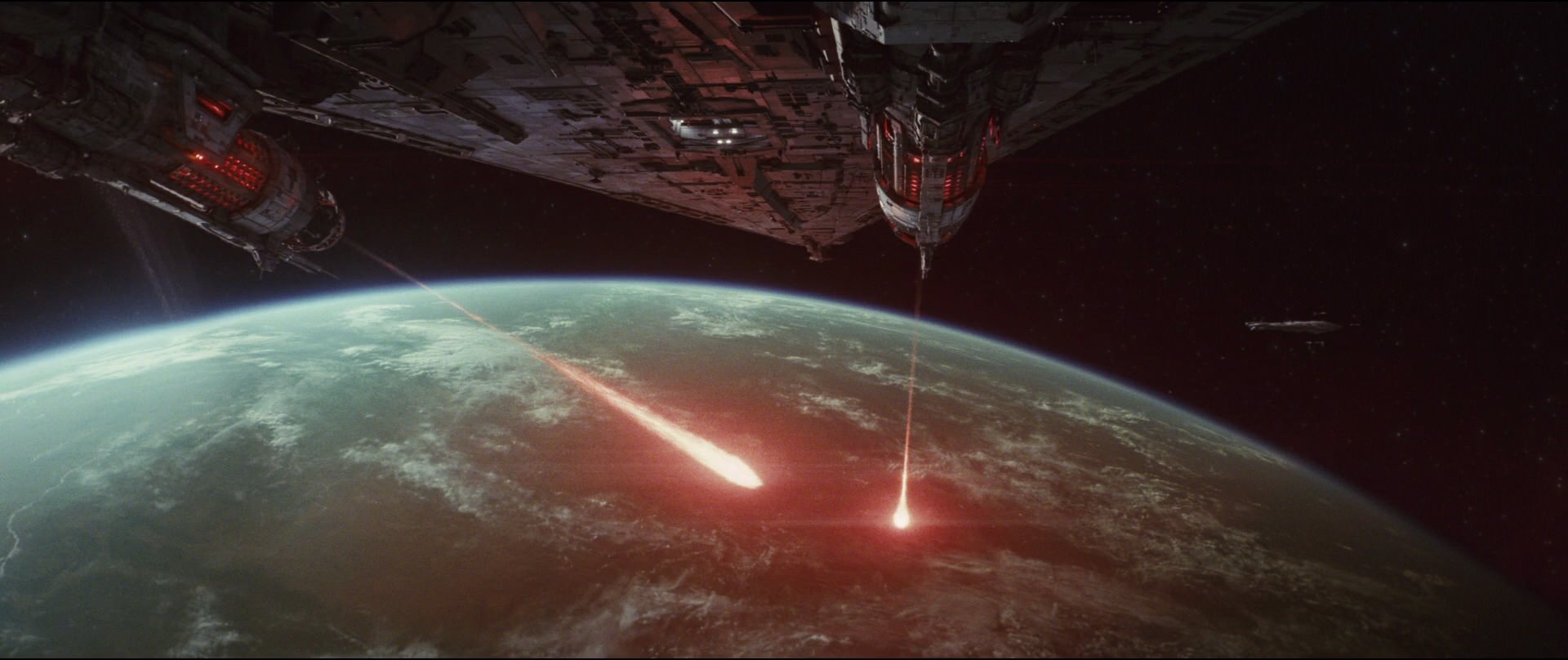
A First Order Mandator IV-class Siege Dreadnought. According to Caluan Ematt, the First Order may have used technology and inspiration from the Onager.
Colonel Delto's report on the Siege Breaker was incorporated into The Rebel Files, a physical data archive that contained a non-electronic copy of sensitive information. The physical archive was buried on the Mid Rim world of Durkteel during an Imperial bombardment. The depository was excavated in 34 ABY and soon reached General Leia Organa of the Resistance, a private military with roots to the Rebel Alliance and supported by some members of the New Republic. At that time, the Resistance was locked in a Cold War with the First Order, the successor government of the Galactic Empire. Resistance Major Caluan Ematt reviewed the documentation related to the Onager-class Star Destroyer and left a written annotation.
Major Ematt wrote on the document in The Rebel Files that detailed the Onager, believing that was what the First Order was involved in, and that it would represent a more containable risk. The concept of using heavy armament for orbital bombardments and long-ranged naval warfare was implemented into the First Order Navy's Mandator IV-class Siege Dreadnought.
The Onager-class Star Destroyer was first mentioned and pictured in the 2017 boxset and reference book Star Wars: The Rebel Files, where it was identified as the Siege Breaker. The book was authored by Daniel Wallace and the image of the Siege Breaker was illustrated by Diogo Costa. It was first identified as the Onager-class Star Destroyer in a August 1, 2019 news article by Fantasy Flight Games on its then-upcoming Star Wars: Armada expansion packs, Onager-class Star Destroyer Expansion Pack and Nadiri Starhawk Expansion Pack, both released on January 31, 2020. The company's February 28, 2020 Star Wars Roleplaying supplement sourcebook, Starships and Speeders, also identifies the starship as the Imperial Siege Breaker.
Lucasfilm Story Group executive Leland Chee confirmed on Twitter that, in developing the Onager-class for Star Wars: Armada, the design came first. When asked how the design for the Onager-class came to be, Chee stated that the Onager-class was designed for The Rebel Files. When Fantasy Flight Games saw the design, it was further developed for their product, as the design was appealing and fulfilled a gameplay need. In the English and Latin languages, the onager (ˈɑnədʒər) was a type of Roman siege catapult weapon. It derived its name from the Syrian wild ass due to the animal and the weapon's similar kicking action.
- Star Wars: The Rebel Files
- Starships and Speeders
- Star Wars Starships & Vehicles 4
- Star Wars: The Rise and Fall of the Galactic Empire